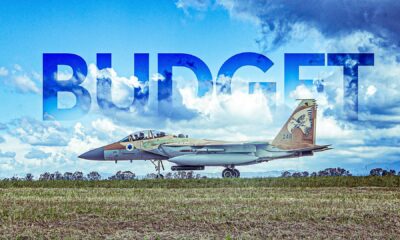World
Boeing Develops New Patents to Combat Turbulence for Safer Flights

Turbulence remains a significant safety concern in commercial aviation, with studies indicating tens of thousands of moderate to severe turbulence events occurring each year. While most turbulence does not result in injuries, unexpected turbulence can lead to serious harm, particularly when passengers are unprepared. In response to this challenge, Boeing has recently filed patents for two innovative systems aimed at enhancing turbulence detection and management.
Innovative Patents Address Turbulence Detection
The two patents, titled US4258823A and EP1842081A2, reflect Boeing’s commitment to addressing the growing issue of turbulence. As turbulence events have increased in frequency, the aviation industry is turning to advanced technologies to mitigate risks. One notable patent, the System for Measuring Turbulence Remotely, utilizes advanced electromagnetic sensors to provide pilots with timely warnings of turbulence, allowing for improved navigation decisions. Boeing envisions this system as part of a global network capable of producing real-time 3D turbulence maps.
The second patent, known as the Inflow Turbulence Control Structure, focuses on the testing of engines and airframes. By recreating in-flight conditions during ground tests, Boeing aims to enhance the accuracy of testing data, ultimately leading to better aircraft designs that can withstand turbulence more effectively.
Enhancing Weather Monitoring Capabilities
Existing weather and radar systems offer valuable insights into potential turbulence zones, but their accuracy can vary, particularly in less monitored regions. To improve this, Boeing is developing a system that integrates electromagnetic signal changes with satellite data. This System for Measuring Turbulence Remotely aims to filter out extraneous factors like aircraft movement, providing pilots and ground teams with a clearer understanding of weather conditions.
Real-time data sharing is a crucial component of this technology, enabling other aircraft and air traffic control centers to receive advanced turbulence warnings. Over time, this system has the potential to evolve into a comprehensive global network for weather prediction.
Boeing’s advancements come at a critical time, as the National Transportation Safety Board (NTSB) reported that over one-third of all scheduled commercial air accidents between 2009 and 2018 were attributed to turbulence. With climate change predictions suggesting an increase in turbulence frequency, enhancing detection systems is imperative for ensuring passenger safety.
Industry-Wide Efforts to Address Turbulence
Boeing is not alone in its pursuit of turbulence solutions. Competitors such as Airbus are also developing innovative technologies. Airbus’s Turbulence EDR (Eddy Dissipation Rate) system, for instance, uses onboard sensors to identify turbulence and share reports, creating a more comprehensive understanding of turbulence patterns globally.
Artificial intelligence is further emerging as a vital tool in turbulence prediction. An AI-based system developed by All Nippon Airways (ANA) and BlueWX Company Limited has shown an impressive 86% detection success rate, underscoring the potential of AI in improving flight safety.
As turbulence detection measures evolve, the importance of passenger safety remains paramount. The International Civil Aviation Organization (ICAO) reported that approximately 75% of serious injuries in 2024 were caused by turbulence-related incidents. Although fatalities are rare, severe turbulence can lead to significant injuries, emphasizing the need for ongoing advancements in detection technology.
Understanding Turbulence and Passenger Safety
For passengers, turbulence is a routine aspect of flying, with most experiences being mild. However, in severe cases, injuries can occur, often due to cabin debris during turbulent episodes. Airlines typically activate seatbelt signs in anticipation of turbulence to keep passengers safe. Passengers are advised to secure loose items and remain seated when turbulence is expected.
Recent incidents highlight the ongoing risks associated with turbulence. In July 2025, a Delta Air Lines flight from Salt Lake City to Amsterdam encountered turbulence, resulting in 25 hospitalizations and numerous minor injuries. Similarly, an Air France A320 experienced severe turbulence during descent, injuring five passengers. These incidents underscore the urgent need for improved turbulence detection and response strategies.
As the aviation industry continues to innovate in turbulence management, the focus on safety remains a central priority. The collaboration of manufacturers, researchers, and technology developers will play a crucial role in enhancing passenger safety in the years to come.
-

 Science2 weeks ago
Science2 weeks agoResearchers Challenge 200-Year-Old Physics Principle with Atomic Engines
-

 Entertainment1 week ago
Entertainment1 week agoSyracuse Stage Delivers Lively Adaptation of ‘The 39 Steps’
-

 World2 weeks ago
World2 weeks agoGlobal Military Spending: Air Forces Ranked by Budget and Capability
-

 Politics2 weeks ago
Politics2 weeks agoNHP Foundation Secures Land for 158 Affordable Apartments in Denver
-

 Politics6 days ago
Politics6 days agoHamas Chief Stresses Disarmament Tied to Occupation’s End
-

 Politics7 days ago
Politics7 days agoNFL Confirms Star-Studded Halftime Show for Super Bowl LVIII
-

 World1 week ago
World1 week agoBoeing’s Aircraft Production: Assessing Numbers and Challenges
-

 Lifestyle1 week ago
Lifestyle1 week agoTrump’s Push to Censor National Parks Faces Growing Backlash
-

 Health2 weeks ago
Health2 weeks agoNeuroscientist Advocates for Flag Football Until Age 14
-

 Top Stories1 week ago
Top Stories1 week agoUrgent Search for Suspect Who Exposed Himself to Teen Girl
-

 Science1 week ago
Science1 week agoAI Misidentifies Doritos Bag as Gun, Triggers Police Response
-

 Lifestyle1 week ago
Lifestyle1 week agoRed Bluff High School’s Elli Nolan Named Rotary Student of the Month









